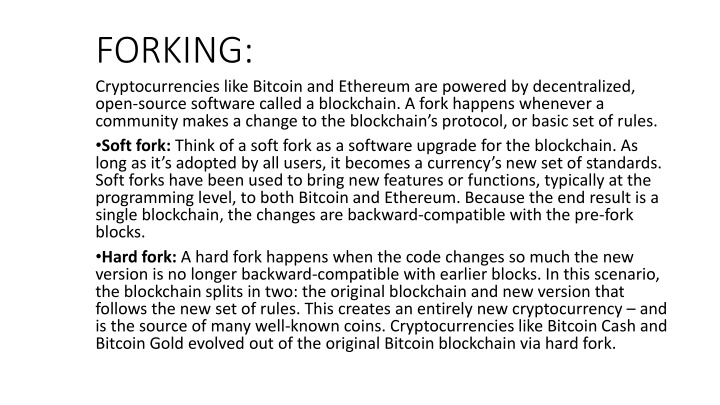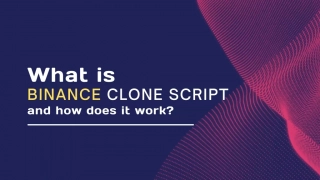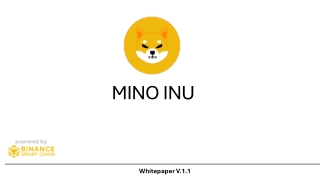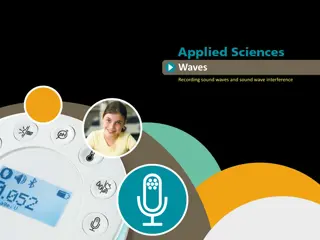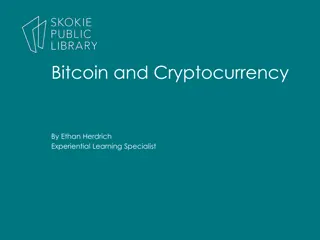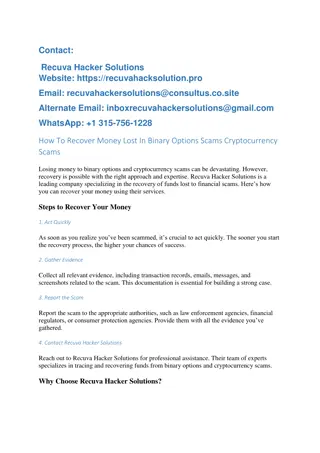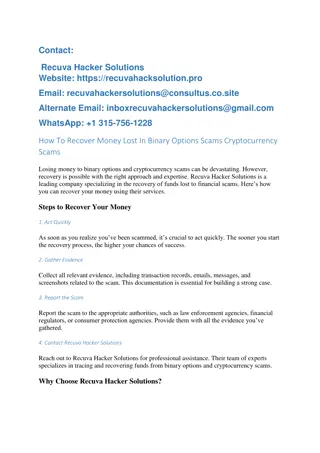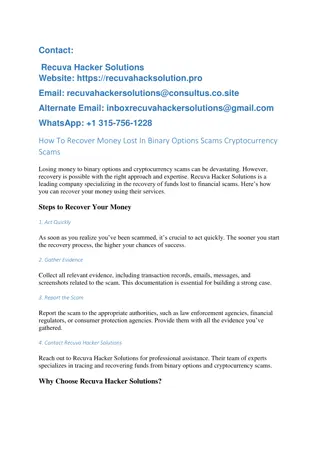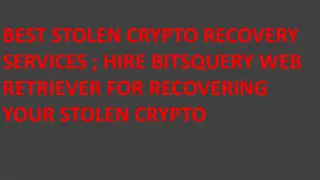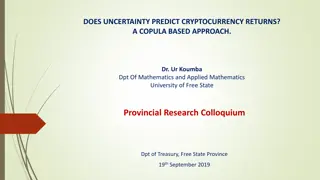Cryptocurrency Forks
Cryptocurrencies like Bitcoin and Ethereum operate on a decentralized blockchain. Forks, such as soft forks and hard forks, bring changes to the protocol. Learn about mining, anonymity issues, and consensus in the cryptocurrency world.
Download Presentation

Please find below an Image/Link to download the presentation.
The content on the website is provided AS IS for your information and personal use only. It may not be sold, licensed, or shared on other websites without obtaining consent from the author.If you encounter any issues during the download, it is possible that the publisher has removed the file from their server.
You are allowed to download the files provided on this website for personal or commercial use, subject to the condition that they are used lawfully. All files are the property of their respective owners.
The content on the website is provided AS IS for your information and personal use only. It may not be sold, licensed, or shared on other websites without obtaining consent from the author.
E N D
Presentation Transcript
FORKING: Cryptocurrencies like Bitcoin and Ethereum are powered by decentralized, open-source software called a blockchain. A fork happens whenever a community makes a change to the blockchain s protocol, or basic set of rules. Soft fork: Think of a soft fork as a software upgrade for the blockchain. As long as it s adopted by all users, it becomes a currency s new set of standards. Soft forks have been used to bring new features or functions, typically at the programming level, to both Bitcoin and Ethereum. Because the end result is a single blockchain, the changes are backward-compatible with the pre-fork blocks. Hard fork: A hard fork happens when the code changes so much the new version is no longer backward-compatible with earlier blocks. In this scenario, the blockchain splits in two: the original blockchain and new version that follows the new set of rules. This creates an entirely new cryptocurrency and is the source of many well-known coins. Cryptocurrencies like Bitcoin Cash and Bitcoin Gold evolved out of the original Bitcoin blockchain via hard fork.
MINING Because a distributed system has no single owner, machines are free to join the Ethereum network at will and begin validating transactions. This process is known as mining. Mining nodes confer to arrive at a consensus about the order of transactions across the system, which is necessary to tabulate everyone s account balances on the fly, even as many transactions pass through the network. This process consumes electricity, which costs money, and so miners are paid a reward for each block they mine: about 5 ether. Mining is the process of using computational work to nominate a block that miner s version of recent transaction history as the canonical block for this, the most recent block on the chain. Mining is the process by which the Ethereum network reaches consensus about the order of transactions in a given period of time, which in turn allows the EVM to make valid state transitions. Mining is important because it is the process by which consensus is reached in the system, and by which ether is created. Bitcoin also uses mining to reach consensus, but the way things work in Ethereum is a little bit different, owing to its ability to execute smart contracts.
Anonymity in Cryptocurrency 1. Bitcoins and ether are not anonymous payment instruments. Anyone who knows your public key can look on the blockchain and see the dates and amounts of transactions coming in and out of your account. From this data, they might be able to put together a pattern of transactions from which they could deduce your activities. Federal authorities are already using machine-learning transactions to decode spending patterns on darkmarket sites such as AlphaBay. 2. Anonymity, secrecy, and privacy in cryptocurrency are generally conflated by newbies, sometimes with disastrous ends. Bitcoin and Ethereum addresses are pseudonymous by nature; they re not linked to your real name or information. But every transaction you send is public, in the sense that anyone can see the transaction on the blockchain. This is why public blockchains are touted for their transparency; if you know someone s public key, you can look up all their transactions.. 3. Data within smart contracts themselves are encoded but not encrypted. Encryption is used only to hash large datasets and verify transaction senders and recipients. However, you can encrypt data yourself before putting it into an Ethereum smart contract, if you d like to use the public Ethereum chains in a private manner
Consensus: The biggest challenge in a decentralized system is achieving consensus about which node will propose the new block. The best strategy is that only one node should propose a block at a time and the rest of the nodes should validate the transactions in the block and add to their blockchains if transactions are valid. If any one node proposes a block and the rest of the nodes agree on it, then all those nodes add that block to their respective blockchains. The agreement about who proposes a block is called consensus. The system is designed in such a manner that players are rewarded for playing by the rules and penalized for bad behavior. Hence, the reward becomes a reason for everyone playing by the rules. The goal of consensus is to ensure that the network is robust enough to sustain various types of attacks.
PROOF OF WORK The PoW consensus mechanism is used in Bitcoin. The idea behind the PoW algorithm is to essentially do a lot of computation for a block of transactions before it gets proposed to the whole network.APoW is actually a piece of data that is difficult to produce in terms of computation and time, but easy to verify. PoW was initially used to prevent email spams. If a lot of computation is to be done before one can send an email, then spamming a lot of people would require a lot of computation to be performed which can act as a deterrent to an adversary. Similarly, in blockchain, a lot of computations need to be done before proposing a block. Hence, proposing a block is a lot of hard work which is rewarded. However, if someone is playing mischief and injecting a fraudulent transaction then rejection of that block by the rest of the nodes will be very costly.
PROOF OF STAKE The Proof of Stake (PoS) algorithm is another popular distributed consensus algorithm.It is used for validating blocks of transactions and not for mining new coins. In PoS systems, the validators have to bond their stake,i.e. mortgage some amount as stake, to be able to participate in validating the transactions. The probability of a validator being selected is proportional to their stake; the more the amount at stake, the greater is their chance to validate a new block of transactions. A miner only needs to prove they own a certain percentage of all coins available at a certain time in a given currency system.
PROOF OF BURN Proof of burn is one of the several consensus mechanism algorithms implemented by a blockchain network to ensure that all participating nodes come to an agreement about the true and valid state of the blockchain network. This algorithm is implemented to avoid the possibility of any cryptocurrency coin double-spending. Proof of burn follows the principle of burning the coins held by the miners that grant them mining rights. Proof of burn (POB) is an alternative consensus algorithm that tries to address the high energy consumption issue of a POW system. POB is often called a POW system without energy waste. It operates on the principle of allowing miners to burn virtual currency tokens. They are then granted the right to write blocks in proportion to the coins burnt.
To burn the coins, miners send them to a verifiably un-spendable address. This process does not consume many resources (other than the burned coins) and ensures that the network remains active and agile. Depending upon the implementation, miners are allowed to burn the native currency or the currency of an alternate chain, such as Bitcoin. In exchange, they receive a reward in the native currency token of the blockchain
Difficulty Level: Blockchain uses a concept of difficulty level. The user has to find a number below the difficulty level. It can be found by trying out a lot of numbers(puzzle friendliness). So, proposing a block is finding a value by trying all possible values to meet the criteria. The difficulty level is adjusted further after every new block to keep a check on how fast a new block is proposed. Since, all the participating nodes are solving it, it is impossible to predict which node would solve it first. Once the puzzle is solved, that node proposes a block. In case of public blockchains, the nodes that are investing their computing resources are rewarded for their honest behavior.(block reward)
